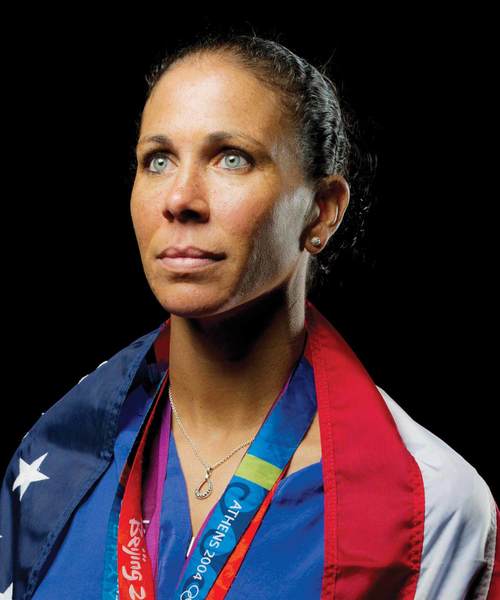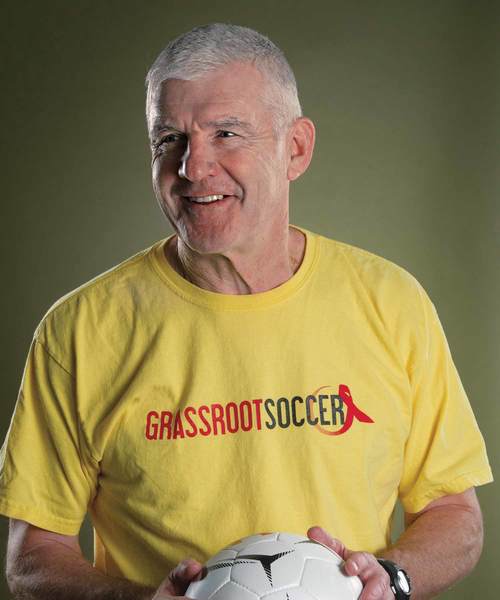
Shannon Boxx
Lupus No Obstacle to Gold Medals
Watch any game featuring the United States Women’s National Soccer Team, and you’ll quickly notice that the American midfielder wearing number seven is a defensive powerhouse.
On the field she is a veteran enforcer, a grinder, a do-it-all dynamo with an affinity for fearless tackling.
Her name is Shannon Boxx. She is a veteran midfielder, a three-time Olympic gold medalist and a graduate from the University of Notre Dame. And, since 2007, she has lived with lupus, an autoimmune disease with no known cure.
By refusing to let lupus define her, Boxx defines herself: She is a fighter, a competitor and a symbol of endurance.
Boxx first arrived at Notre Dame in the fall of 1995 from Torrance, Calif., as a high school All-America center midfielder. But with All-America junior Cindy Daws anchoring the Fighting Irish at center midfield, Irish coach Chris Petrucelli dovetailed the talented Boxx into Notre Dame’s starting lineup wherever she was willing to play. That was everywhere.
“There was no doubt that I was willing to do whatever it took to be on the field,” says Boxx, who has earned a reputation as a workhorse midfielder. “I played a couple different positions in that year.”
Boxx started dreaming of the Olympics when the Irish capped their ’95 season by defeating Portland 1-0 in a thrilling, triple-overtime victory. In her first collegiate season, she and her teammates won Notre Dame’s first-ever national championship in women’s soccer.
Boxx traveled from the championship podium in the fall of ’95 to the sidelines of the Atlanta Summer Olympic Games, where she watched her older sister, Gillian, win a gold medal in softball.
“It was amazing,” Boxx says.
“The competitive nature and the competitiveness in myself after winning a national championship, that started it. But to go see the Olympics firsthand ignited that voice that said, ‘Maybe I can do this.’”
Boxx graduated with degrees in psychology and African-American studies and set off for a globetrotting professional soccer career. Then the first symptoms struck.
In 2002, she started suffering from such intense fatigue that she had difficulty walking up stairs and finishing her workouts. After months of battling exhaustion, Boxx was diagnosed with Sjögren’s syndrome, a systemic autoimmune disease.
But Boxx—“Boxxy” to her teammates—battled through the sickness. She earned a spot on the 2003 Women’s National Team and started all six games of the 2004 Athens Summer Olympic Games, scoring the opening goal of the tournament against Greece en route to her first Olympic gold medal.
“I think after that first win in the Athens Olympics we were standing at the podium and I just looked back and thought, ‘Wow, this is pretty special,’” she says. “All these things that I went through to finally get to that moment—to be on the top podium, singing the national anthem with my teammates—I think it was pretty special.”
But as her symptoms worsened, Boxx’s doctors struggled to diagnose the disease that was causing painful swelling in her hands, elbows and knees. After a year of false diagnoses, doctors finally pinpointed the problem in 2007: Shannon Boxx had lupus.
Lupus varies in severity across patients but can affect every part of the body, particularly skin and joints as well as internal organs like the heart, lungs and kidneys. Like Sjögren’s syndrome, lupus occurs nine times more frequently in women. Lupus is not contagious and is treatable with immunosuppression—although medicine affects patients differently—but there is no known cure. If left untreated, it can be deadly.
“From the minute I was diagnosed in 2007, extreme fatigue was a huge issue and joint pain was a huge issue,” Boxx says. “There’s no ignoring it, that’s for sure. The fatigue you feel, it’s like a truck hitting you. It feels like it takes every single piece of energy just to run, just to move.”
Boxx’s initial relief at finally having a name for her persistent pain quickly gave way to shock: even after fighting an autoimmune disease for years, she knew very little about lupus.
“When I was first diagnosed, I was afraid to talk about it because I was afraid people would treat me differently,” she says. “I was afraid it could possibly hurt my career. So I kept it pretty quiet. My family obviously knew, and my close friends back home knew.”
Because painful symptoms flare up randomly, lupus can take a psychological toll simply from anxiety. So Boxx confided in current team captain and fellow veteran defender Christie Rampone.
“Christie would know if I was having a bad day, but other people wouldn’t ever notice that my effort changed,” Boxx says. “It was nice to know I had that … I was able to get through training. Was I good that day? Absolutely not. I probably played horribly. And I know that I was able to push through that game, and as soon as that game was over I was wiped out.”
But Boxx pushed forward tenaciously, earning a place on the U.S. Women’s National Team for the 2007 World Cup, the so-called “Greatest Team You’ve Never Heard Of.” Although they finished third, Boxx and her vibrant teammates caught the world’s attention with their dramatic, athletic style.
When Boxx and her teammates kicked, headed and tackled their way to a gold-medal finish in the 2008 Beijing Olympics, they leaped into the global spotlight and the hearts of Americans everywhere. Skippered by coach Pia Sundhage and anchored by Boxx at midfield for every Olympic minute, the charismatic Americans became “The Team Everyone Loved to Cheer For.”
Boxx avoided flare-ups in the World Cup and the Olympics, but she played through pain during training sessions and even the prestigious international Algarve Cup. Through it all, she kept her lupus hidden from the public, in defiance of the disease that left her exhausted and immobile. Yet even with her resolve, she learned to accept her limits—that she had to walk away from sessions when the pain was too intense.
In the spring of 2012, she decided to tell the world about her lupus. Despite her initial trepidation to go public for fear being labeled or treated differently, Boxx found strength when her teammates—and thousands of people with lupus—greeted her announcement with an overwhelming display of support.
“I had no idea I could inspire so many,” she says. “If I had known that I would have come out a lot earlier and told my story. I had no idea that telling my story could inspire so many other people—people that have lupus, people that don’t have lupus—and I’m so happy now that I have chosen to speak about this.”
As the world focused on the 2012 London Summer Olympic Games, Boxx became a global symbol of toughness—and not just because she battled lupus. Only 17 minutes into the opening match against France, she suffered a critical hamstring injury that sidelined her.
“To not even be able to enjoy it because I got hurt was pretty devastating,” she says. “Not knowing if this would be my last Olympics, I didn’t want to have that memory that this was how it ended.”
Boxx rehabbed energetically, spurred on by her supportive teammates and her natural tenacity honed from years of battling an autoimmune disease. As her team jogged into Wembley Stadium before more than 80,000 fans to play the same Japan team that had defeated them in the 2011 World Cup, there was number seven at midfield.
Boxx played all 90 minutes, freeing teammate Carli Lloyd to move forward into her normal attacking role. Lloyd scored two goals to defeat Japan, 2-1, and America cheered as Boxx and her team celebrated their third consecutive Olympic gold.
Since she joined forces with the Lupus Foundation of America, Boxx has drawn her inspiration from stories of perseverance she hears from around the nation—particularly from young soccer players.
Boxx describes a story she received from a young girl with severe lupus: “Even though she has it bad, she says ‘Hey, if Shannon’s going out and playing and she has lupus, I can do the same—maybe not to the same level, but I can get up and go for a walk.’ I think it just inspires people to want to try.
“By talking about my story, I’m meeting so many people who are so much worse than me and are willing to fight and take this disease head-on and beat it,” she says.
She takes courage from a 14-year-old soccer player she met in Chicago. Despite relying on heavy medication and missing games because of lupus, this young player, like Boxx, motivates her teammates and spreads the word about the “cruel mystery” that affects millions of Americans.
“Lupus is underfunded, so if I can continue to promote awareness, that’s the biggest thing,” she says. “More and more people I talk to say, ‘Now I know what lupus is. I looked it up because I know you have it.’ I know it might be small, but I think [by] sharing my story … more people will learn what lupus is and how they can help.”
To fight through workouts while suffering from an autoimmune disease that leaves her fatigued and aching even before she starts warming up, Boxx must have a truly Olympian reserve of physical, mental and emotional strength.
“When you’re on that podium again, you start to realize all the things that help you get to this point,” she says. “Notre Dame has always been that for me.”

